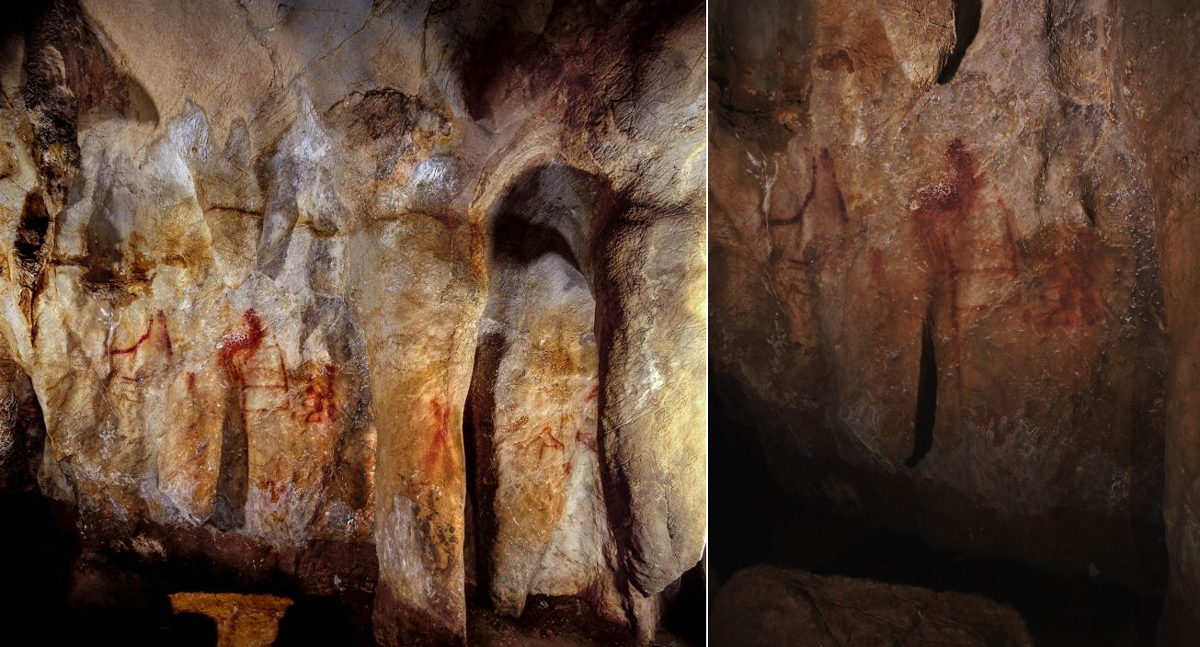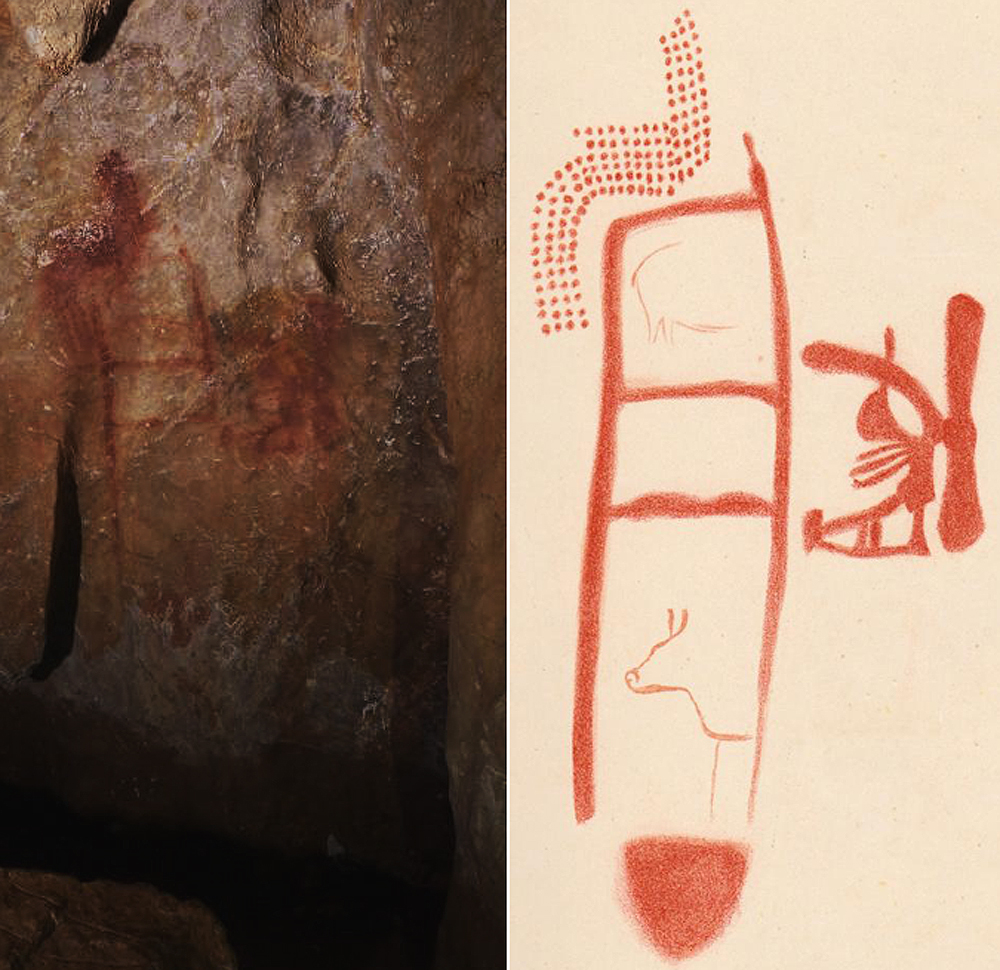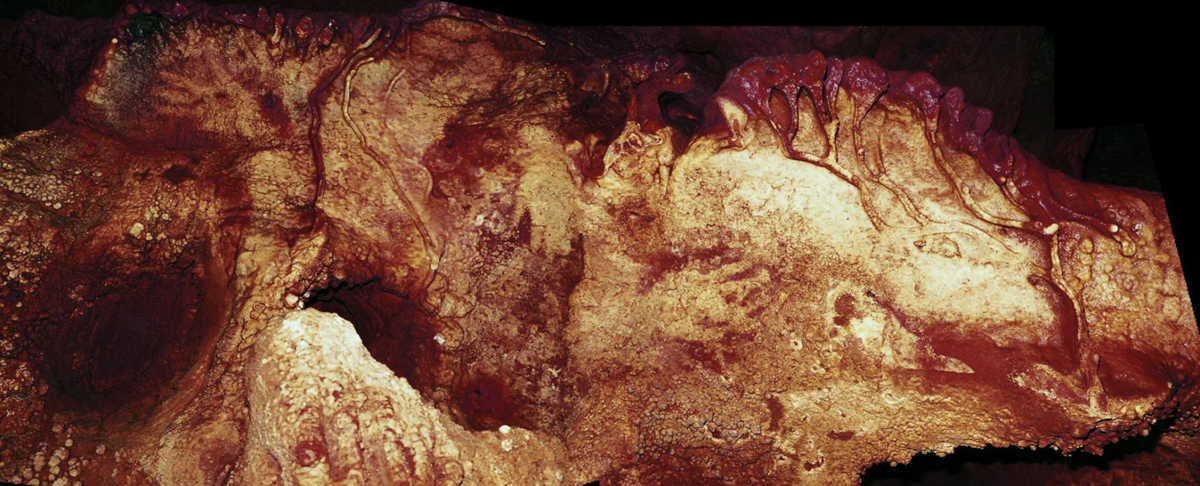


Paleoanthropologist Genevieve von Petzinger talks about the exciting new discovery of 65,000-year-old Neanderthal cave art in Europe.
PALEO VLOG 02.22.2018 from Dillon von Petzinger on Vimeo.
She explains how the dating was done and why this study could be the discovery of the decade.

The ladder-shaped painting on this wall in the La Pasiega cave in Spain is older than 64,000 years. Scientists believe it was made by Neanderthals. Image: P. Saura.
In three caves across Spain, researchers have found more than a dozen examples of rock art paintings that are more than 65,000 years old.

The ladder-like painting in the La Pasiega cave. Animals, visible in a rendering made by Breuil in 1913, right, are thought to have been added later by modern humans. Image: C.D Standish, A.W.G. Pike and D.L. Hoffmann.
Coauthor João Zilhão, a University of Barcelona archaeologist, states that Neanderthals were the cognitive equals of Homo sapiens.

Hand stencils in the Maltravieso Cave in Spain dated to at least 66,000 years ago, believed to have been made by Neanderthals. Image: H. Collado.
If the results of the research hold up, the implications are that symbolic art may date back to the common ancestor of Homo sapiens and Neanderthals some 500,000 years ago.
Read more in Geometric Signs - A New Understanding by Genevieve von Petzinger:
by Bradshaw Foundation
Friday 09 August 2024
by Bradshaw Foundation
Wednesday 24 July 2024
by Bradshaw Foundation
Thursday 04 July 2024
by Bradshaw Foundation
Monday 30 May 2022
by Bradshaw Foundation
Wednesday 19 January 2022
by Bradshaw Foundation
Thursday 06 January 2022
by Bradshaw Foundation
Tuesday 21 March 2023
by Bradshaw Foundation
Tuesday 07 February 2023
by Bradshaw Foundation
Thursday 19 May 2022
by Bradshaw Foundation
Monday 04 December 2023
by Bradshaw Foundation
Friday 30 June 2023
by Bradshaw Foundation
Thursday 06 April 2023
by Bradshaw Foundation
Friday 14 July 2023
by Bradshaw Foundation
Monday 22 November 2021
by Bradshaw Foundation
Tuesday 12 July 2016
by Bradshaw Foundation
Tuesday 26 November 2024
by Bradshaw Foundation
Monday 27 November 2023
by Bradshaw Foundation
Friday 07 October 2022
by Bradshaw Foundation
Friday 09 August 2024
by Bradshaw Foundation
Wednesday 24 July 2024
by Bradshaw Foundation
Thursday 04 July 2024
by Bradshaw Foundation
Monday 30 May 2022
by Bradshaw Foundation
Wednesday 19 January 2022
by Bradshaw Foundation
Thursday 06 January 2022
by Bradshaw Foundation
Tuesday 21 March 2023
by Bradshaw Foundation
Tuesday 07 February 2023
by Bradshaw Foundation
Thursday 19 May 2022
by Bradshaw Foundation
Monday 04 December 2023
by Bradshaw Foundation
Friday 30 June 2023
by Bradshaw Foundation
Thursday 06 April 2023
by Bradshaw Foundation
Friday 14 July 2023
by Bradshaw Foundation
Monday 22 November 2021
by Bradshaw Foundation
Tuesday 12 July 2016
by Bradshaw Foundation
Tuesday 26 November 2024
by Bradshaw Foundation
Monday 27 November 2023
by Bradshaw Foundation
Friday 07 October 2022
by Bradshaw Foundation
Tuesday 19 November 2024
by Bradshaw Foundation
Wednesday 22 May 2024
by Bradshaw Foundation
Friday 10 November 2023
Friend of the Foundation











